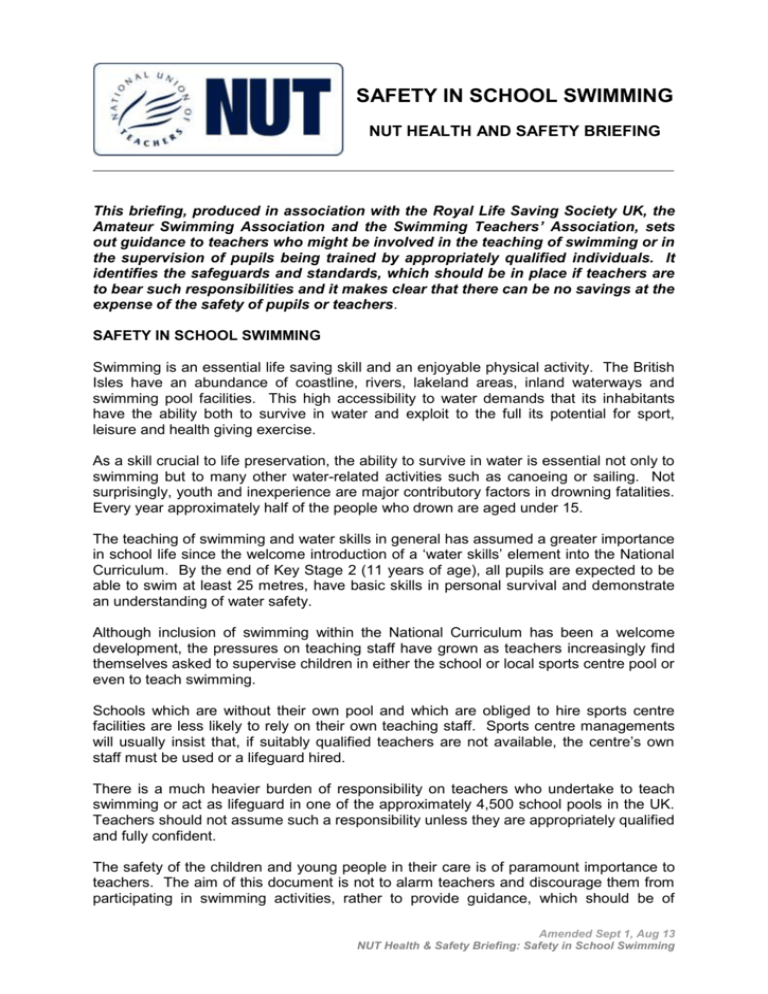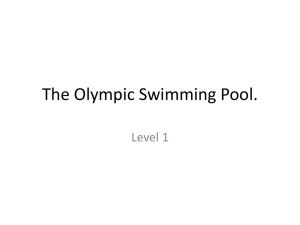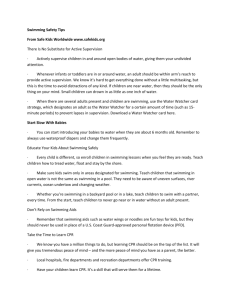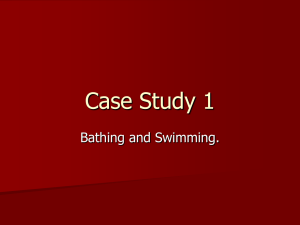SAFETY IN SCHOOL SWIMMING
advertisement

SAFETY IN SCHOOL SWIMMING NUT HEALTH AND SAFETY BRIEFING This briefing, produced in association with the Royal Life Saving Society UK, the Amateur Swimming Association and the Swimming Teachers’ Association, sets out guidance to teachers who might be involved in the teaching of swimming or in the supervision of pupils being trained by appropriately qualified individuals. It identifies the safeguards and standards, which should be in place if teachers are to bear such responsibilities and it makes clear that there can be no savings at the expense of the safety of pupils or teachers. SAFETY IN SCHOOL SWIMMING Swimming is an essential life saving skill and an enjoyable physical activity. The British Isles have an abundance of coastline, rivers, lakeland areas, inland waterways and swimming pool facilities. This high accessibility to water demands that its inhabitants have the ability both to survive in water and exploit to the full its potential for sport, leisure and health giving exercise. As a skill crucial to life preservation, the ability to survive in water is essential not only to swimming but to many other water-related activities such as canoeing or sailing. Not surprisingly, youth and inexperience are major contributory factors in drowning fatalities. Every year approximately half of the people who drown are aged under 15. The teaching of swimming and water skills in general has assumed a greater importance in school life since the welcome introduction of a ‘water skills’ element into the National Curriculum. By the end of Key Stage 2 (11 years of age), all pupils are expected to be able to swim at least 25 metres, have basic skills in personal survival and demonstrate an understanding of water safety. Although inclusion of swimming within the National Curriculum has been a welcome development, the pressures on teaching staff have grown as teachers increasingly find themselves asked to supervise children in either the school or local sports centre pool or even to teach swimming. Schools which are without their own pool and which are obliged to hire sports centre facilities are less likely to rely on their own teaching staff. Sports centre managements will usually insist that, if suitably qualified teachers are not available, the centre’s own staff must be used or a lifeguard hired. There is a much heavier burden of responsibility on teachers who undertake to teach swimming or act as lifeguard in one of the approximately 4,500 school pools in the UK. Teachers should not assume such a responsibility unless they are appropriately qualified and fully confident. The safety of the children and young people in their care is of paramount importance to teachers. The aim of this document is not to alarm teachers and discourage them from participating in swimming activities, rather to provide guidance, which should be of Amended Sept 1, Aug 13 NUT Health & Safety Briefing: Safety in School Swimming Page 2 of 7 practical benefit. The NUT believes that the teaching of swimming should, in every school, be undertaken in a safe and supervised environment by appropriately trained and qualified staff. Ideally, appropriately qualified teachers should be employed by local authorities and other employers to teach swimming to pupils both in school pools and local sports centres, but the NUT recognises that the current funding climate limits provision in this area. QUALIFICATIONS AND TRAINING Under the Management of Health and Safety at Work Regulations 1999, employers have a clear duty to take into account employees’ capabilities as regards health and safety when entrusting tasks. Employers must also ensure that employees are provided with adequate health and safety training if they take on extra responsibilities, such as the supervision of swimming sessions, thereby exposing themselves, and others, to risk. Any training should be repeated periodically to ensure continued competence. This aspect of the Regulations is particularly significant in respect of school swimming. The three main organisations which provide training in these areas are: Lifesavers: the Royal Life Saving Society (RLSS) UK; Amateur Swimming Association (ASA); Swimming Teachers’ Association (STA). It is recommended that, unless the services of a qualified lifesaver are used, nonspecialist teachers of swimming should possess, as a minimum, a current lifesaving qualification and a basic swimming teachers’ certificate, such as the ASA Level 2 Certificate in Teaching Aquatics (QCF) or the STA Level 2 Award or Certificate in Teaching Swimming (QCF) for those who are taking overall responsibility and the ASA Level 1 Award in Teaching Aquatics for those assisting with the teaching of swimming. A suitable qualification for teachers supervising swimming activities is the STA Level 1 Award in Pool Emergency Procedures (QCF) or the ASA/RLSS National Rescue Award for Swimming Teachers and Coaches, which meet fully all the recommendations on rescue skills laid down in the HSE/Sport England guidance document ‘Managing Health and Safety in Swimming Pools’. Other suitable qualifications, which meet the same requirements are the RLSS UK National Pool Lifeguard Qualification and the STA Level 2 Award for Pool Lifeguard Qualification. The rescue skills which are required of lifeguards and which these awards cover are as follows: to work effectively as part of a team; to observe the water and effect a prompt rescue, using any emergency equipment provided; to give effective resuscitation by expired air resuscitation and by cardiopulmonary resuscitation; to give emergency first aid if no fully-trained first aiders are available. All lifeguards need at least basic first aid training to recognise serious injury and give NUT Health & Safety Briefing: Safety in School Swimming Page 3 of 7 immediate care until further assistance arrives. The ‘Managing Health and Safety in Swimming Pools’, available to download from the HSE website at www.hse.gov.uk/pubns/books/hsg179.htm document stresses the need for rescue skills to be practised regularly and for refresher training to be given. All the above life guarding/lifesaving qualifications remain valid for only 24 months at a time to ensure that skills are updated regularly. The ASA Level 1 Award (QCF) qualifies the holder to assist with the teaching of swimming under the guidance of the holder of an ASA or STA Teachers’ Certificate. These courses run for 12 hours, 6 of which must take place on the poolside and cover safety, hygiene, teaching aids and equipment and teaching methods with non-swimmers and beginners up to intermediate level. The ASA Level 2 Certificate in Teaching Aquatics , the STA Level 2 Award in Swimming Teaching or the STA Level 2 Certificate in Swimming Teaching should be held by any teacher in charge of teaching swimming to a group of school pupils. To be awarded the ASA or STA Level 2 Certificate, candidates must be capable of teaching the whole range of pupils from non-swimmers to those approaching a good competitive standard. These Certificates contain a practical assessment of teaching ability and a written examination. NUMBER OF LIFEGUARDS Guidelines on lifeguard numbers are given in the HSC/Sport England document ‘Managing Health and Safety in Swimming Pools’. In that document, the HSE does not make specific recommendations on lifeguard numbers as it is felt that this is a matter for the pool management to determine. However, the document does recommend minimum numbers for certain standard sizes of rectangular pool when used for general public swimming and without diving or other special equipment. These are as follows: Standard pool size in metres Area M2 Minimum number of lifeguards Minimum number of lifeguards in busy conditions 20 x 8.5 170 1 2 25 x 8.5 212 1 2 25 x 10 250 1 2 25 x 12.5 312 2 2 33.3 x 12.5 416 2 3 50.0 x 20.0 1000 4 6 NUT Health & Safety Briefing: Safety in School Swimming Page 4 of 7 Additional lifeguards may be required if there are hidden areas of water or where there are extensive areas of water deeper than 2 metres. Conversely, fewer may be required where the pool only contains water of 1 metre or less in depth, or during programmed school swimming sessions, taking into account the ages and swimming abilities of the pupils, and the numbers being supervised. Where a school is using a public pool it will have to comply with the lifeguarding policy set down by the pool management. In school pools, the school should adhere to local authority guidelines, which should, as a minimum, cover the points mentioned in this guidance. DENSITY OF SWIMMERS The Department of the Environment has recommended that a minimum water area of 3m2 per bather should be allowed. This is only a recommendation. A higher density may be reasonable in a pool with a large area of shallow water and a lower density may be necessary where diving is permitted or where water slides are in use. An assessment will also have to be made of the time available for the session, the number of pupils taught in each session and how much time can then be devoted to each pupil. Clearly, as class sizes increase, direct contact time is reduced and the ability of the teacher to correct faults and encourage individuals falls to a level where the educational benefit to individual pupils becomes negligible. DIVING Swimming teachers and those involved in lifeguarding activities need to be particularly aware of the hazards of diving into water of insufficient depth. Diving into water of insufficient depth can lead to concussion or injury to the head or spine. The most serious of these accidents can lead to tetraplegia (total paralysis below the neck). The latest safety guidance published recommends that children should not be taught to dive where the water depth is less than 1.8 metres. ASA guidance states that when diving is being taught, ideally the water depth should be at least full standing height plus arms and fingers fully extended. Very few pools can, however, provide water of sufficient depth to meet this requirement, particularly for tall children. As it would be far less safe not to teach diving at all to a proportion of the population, the ASA recommends a minimum depth of 1.8m, with the exercise of additional caution. The pool freeboard (distance from the water surface to poolside), must not exceed 0.38 metres. A forward clearance (horizontal distance at which the above minimum depth is maintained), of 7.6 metres must be available. It is also recommended in the document, ‘Diving and Jumping in Swimming Pools’, published by the Chartered Institute for the Management of Sport and Physical Activtiy (CIMSPA) that pupils should be instructed in flat racing dives only. ‘Plain Header’ dives should be avoided. To ensure maximum safety, teachers should not attempt to instruct pupils in diving techniques unless they have obtained at least the ASA Level 2 Certificate in Teaching Aquatics or the STA Level 2 Certificate in Swimming Teaching WATER CLARITY NUT Health & Safety Briefing: Safety in School Swimming Page 5 of 7 Although this is unlikely to be a problem for schools using managed leisure facilities, those schools with their own pools need to be aware of the hazards of unclear water. Cloudy water makes it more difficult for divers entering the water to see swimmers below the surface, or for a casualty to be spotted. If the clarity of a pool’s water begins to deteriorate, the pool should be cleared until a satisfactory standard has been reached. GRILLE COVERS IN SCHOOL SWIMMING POOLS Schools with their own pools need to be aware of the hazards posed by uncovered sump outlet pipes at the bottom of pools. In 1999, a fatal accident occurred in a school swimming pool, where a child’s hand became trapped in the sump outlet pipe at the bottom of the pool. Grille covers need to be securely fixed to the sump. Current industry guidance recommends that grilles should not have holes or gaps wider than 8mm in size. However, the HSE recommends that, where a risk assessment shows that total exclusion of fingers and toes of children and adults is necessary, due to a significant risk of drowning if entrapment occurs, then it is suggested that grille openings do not exceed 4mm in size. If smaller grille sizes are adopted, two other things will change; the water velocity into the sump and the amount of water being passed into the treatment plant. Therefore, the decision to change grille sizes needs to be taken after full consideration of the effects on water circulation and treatment, the position of the outlet sump and the age of the users. In pools which only have one sump outlet, there may be a real risk of a swimmer being able to cover the outlet with part of their body and being held by the suction effect of the pump. In this case, pool operators should make suitable modifications to their swimming pools. These could include: the installation of a second outlet sump located at a sufficient distance away that a lone swimmer cannot cover both outlets; provision of a pressure operated interlock switch on the pump which will isolate the pump if a significant change in suction pressure is detected; or provision of a second outlet line from a spillway or drain, which is permanently open to the suction line. OPERATING PROCEDURES AND EMERGENCY PLANS Teachers involved in school swimming sessions, whether in school or public pools, should always be aware of the normal operating procedures of the pool as well as the plans established to deal with emergencies. The Management of Health and Safety at Work Regulations 1999 require that employers have a system in place to cover health and safety in all aspects of their activities. This could be set out in the health and safety policy statement which is required under the Health and Safety at Work etc Act 1974. Such a system should cover such matters as: planning: adopting a systematic approach so that risks are minimised by the careful selection of facilities and equipment. organisation: putting in place the necessary structure to ensure progressive improvements in health and safety performance. NUT Health & Safety Briefing: Safety in School Swimming Page 6 of 7 control: ensuring that systems for ensuring health and safety are being implemented. monitoring and review: ensuring that policies are kept under review to take into account changing circumstances. More specifically, in respect of swimming activities, the normal operating procedures for swimming pools should cover the following points: details of the pool, including dimensions, and a plan of the building potential risk factors first aid supplies and training conditions for hire to outside organisations emergency equipment and maintenance arrangements lifeguards’ duties systems of work, including lines of supervision and numbers of lifeguards for particular activities. The Management of Health and Safety at Work Regulations also require the preparation of emergency plans to operate in the event of serious danger. For swimming pools, such a plan should include action to be taken in the event of: disorderly behaviour sounding of the alarm to evacuate the building lighting failure structural failure lack of water clarity emission of toxic gases serious injury to a bather discovery of a casualty in the water. Schools operating their own pools should adapt guidelines issued by their local authority to their own individual circumstances. NUT Health & Safety Briefing: Safety in School Swimming Page 7 of 7 FURTHER INFORMATION AND HELP NUT Advice and Assistance Teachers who come under pressure to supervise swimming activities or to teach swimming and who do not feel either fully confident or appropriate qualified should raise the matter as soon as possible with their NUT division secretary or regional office. Further Contacts Listed below are the addresses of a number of organisations from whom more specialist advice may be sought. Lifesavers, The Royal Life Saving Society UK, River House, High Street, BROOM, Warwickshire B50 4HN. Tel: 01789 773994. Website: www.lifesavers.org.uk Amateur Swimming Association, Sportpark, 3 Oakwood Drive, Loughborough, Leics, LE11 3QF. Tel: 01509 618700. Website: www.swimming.org.uk Swimming Teachers’ Association, Anchor House, Birch Street, Walsall, West Midlands WS2 8HZ. Tel: 01922 645097. E-mail: sta@sta.co.uk. Website: www.sta.co.uk Chartered Institute for Management of Sport and Physical Activity (CIMSPA), Sportpark, 3 Oakwood Drive, Loughborough, Leics, LE11 3QF. Sport England, 3rd Floor Victoria House, Bloomsbury Square, London WC1B 4SE. Tel: 08458 508508 Resources ‘Managing Health and Safety in Swimming Pools’ is available from the HSE website (www.hse.gov.uk) price £10.95, or can be downloaded as a free pdf, while ‘Diving in Swimming Pools’ is available from the CIMSPA, price £2.80. Also of interest is the ASA National Curriculum Resource Pack for Swimming and Water Safety, available from the ASA Award Centre, 1 Kingfisher Enterprise Park, 50 Arthur Street, Redditch, Worcestershire B98 8LG, tel: 01527 514288; and the video and pack constituting the RLSS UK Lifeguard Potential Programme, which provides teachers with the basic information to teach water safety and swimming and is available from RLSS UK Enterprises Ltd at Lifesavers Direct, Trinity House, Lisburn, BT28 2XX. NUT Health & Safety Briefing: Safety in School Swimming







